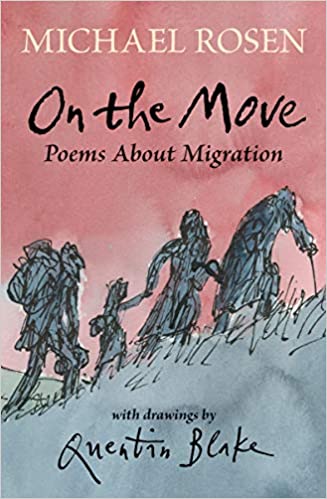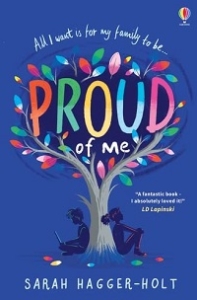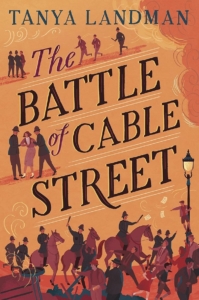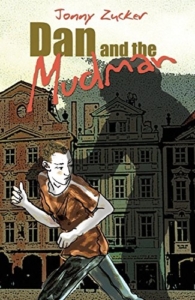
This article is in the Beyond The Secret Garden Category
Beyond the Secret Garden: Jewish representation in British children’s books
In the latest in their long-running Beyond the Secret Garden series, Darren Chetty and Karen Sands-O’Connor consider representations of Jewish people in children’s literature.
Many children in Britain will read books featuring Jewish people in Religious Education lessons. However, Jewishness can also be thought of as an ethnicity, and historically has been seen as a racialised category. Many people identify as ‘secular Jewish’, recognising shared history and certain traditions – and in some cases use of language, while not being religiously observant.
The first recorded Jewish community in Britain arrived in the time of William the Conqueror. In 1190, in the run up to the Third Crusade, the Jewish population of York was massacred and 100 years later King Edward expelled Jews from England. This was not reversed until the 17th century. During the 1911 riot in Tredegar, Wales, Jewish homes and businesses were looted and burned over a period of a week. Winston Churchill, Home Secretary, described the riot as a ‘pogrom’. Antisemitism has a long history in Britain, and an even longer history in Christianity. It was not until the 1960s that Pope Paul VI repudiated the idea of a collective, multigenerational Jewish guilt for the crucifixion of Jesus.
The recent launch of the computer game Hogwarts Legacy brought renewed allegations of antisemitism in the JK Rowling’s Harry Potter series. Many have pointed out that the goblins, who control Gringotts Bank resemble the caricatures depicted in the antisemitic 1903 book, The Protocols of the Elders of Zion, and that a star resembling the Star of David is shown on the floor of the bank in the films. The Campaign Against Antisemitism issued a statement in which they offered the view that ‘mythological associations have become so ingrained in the Western mind’ and their continuation ‘is a testament more to centuries of Christendom’s antisemitism rather than malice by contemporary artists’.
Representation of a minoritized group is often difficult. Individual authors can run the risk of presenting too little information about a character (and potentially falling into stereotypes to ensure the ‘recognition’ of the character as belonging to a specific group) or too much, losing the overall story in an attempt to teach readers about a culture. Too often, Jewish representation has fallen into the former category: Oliver Twist’s Fagin (1838) or Ivanhoe’s Isaac of York (1819) are figures from ‘classic’ literature, regularly abridged for children since they were first published, that reinforce stereotypical depictions of and attitudes toward Jews. Both characters are marked out by their looks as different, and both are constantly referred to by their religion. Isaac of York’s features, according to Walter Scott, ‘would have been considered as handsome, had they not been the marks of a physiognomy peculiar to a race’; Fagin is ‘a very old shrivelled Jew’ with a ‘villainous-looking and repulsive face’. In these ‘classics’, the physical description of Jews as different from Christians is necessary to plots which hinge on their outsider status.
As Madelyn Travis writes, ‘defining Jewishness is complex, varied and contested, even among Jews. Defining Jews and British-Jewishness textually therefore can be fraught with difficulties…’ (2011:112). Despite a significant Jewish population in Britain, few stories about British Jews exist for children. Beyond non-fiction books, most readers, if they encounter Jewish people at all in British children’s books, find them in Holocaust stories. Judith Kerr’s When Hitler Stole Pink Rabbit (1971), opens with the main character Anna discussing her heritage with her friend Elsbeth. Elsbeth probes Anna’s connection to Judaism through stereotypes, and becomes impatient when Anna and her family do not conform to what she ‘knows’ about Jews: ‘if you look the same as everyone else and you don’t go to a special church, how do you know you are Jewish?’ she demands in disgust.
Michael Rosen’s poetry regularly acknowledges his family’s Jewishness and make use of Yiddish phrases he heard growing up (like ‘Two Languages’, included in On the Move: Poems about Migration (2020), which won the CLiPPA Poetry Award). In Please Write Soon (2022), Rosen tells a story through letters of a Jewish teenager from Poland who joins the ‘Anders Army’ and fights the Axis powers. The story is based on the life of his father’s cousin.
Rosen’s The Missing combines narrative non-fiction and poetry to tell a story of family history, of the Holocaust, and of antisemitism, while Rosen stresses from the outset that genocide, racism and hatred of refugees extends to other groups also. It is also the story of a search – and of the sense of loss that continues through generations. We may view this search itself as a form of political resistance, for the Nazis aimed not only ‘to remove people, but also to remove the memory of them’ (p44). Combining narrative non-fiction with poems from previous books, Rosen continually reminds the reader that this is a personal story while helping them to make connections with broader histories. The particularity of his story, and the avoidance of well-worn phrases forces us to respond personally. Writing of the police officers in France who arrested his great-uncle; ‘What did they do then? Have breakfast? What did they say to their families? “We arrested a Jew tonight.” Or were they sorry? Sad? Guilty?’ (p94). Such everyday language reminds us that so many heinous actions were committed by everyday people – and that choices were being made throughout; something that can sometimes be less apparent in traditional textbooks for young people laden with terminology and statistics that can have an emotionally distancing effect. Rosen does not eschew statistics; after sharing letters his family sent each other in attempting to secure safe passage from Poland, he tells us the St Louis ship that carried 900 Jewish refugees from Germany was turned away by the US government and returned to Europe, where many of them died a few years later.
The Missing is supported and checked by the UCL Centre for Holocaust Education, who in 2016 raised concerns about John Boyne’s The Boy in the Striped Pyjamas, a work of fiction that it found was often used as part of teaching about the Holocaust in schools. It found that many young people appeared to draw mistaken and/or misleading conclusions about the Holocaust based on their engagement with the book.
Possibly the first post-war British book to feature a Jewish protagonist, A Box for Benny (1958) was written by Leila Berg, with drawings by Jillian Willet. Benny’s desire for a box to play a game provokes him to make a series of swaps while travelling around his working-class Jewish neighbourhood in Manchester. We encounter a number of characters with popular Jewish surnames, ‘baigels’ and mention of special Saturday meals of sponge cake and wine. However, Benny and his neighbours are not explicitly Jewish and no mention is made of Judaism. It may be that this is an authorial decision to not explain the characters for a mainly non-Jewish readership; they are shown simply getting on with their lives without the need for explanatory commentary. But we learn that Benny is glad to have switched school from one where ‘the children used to sing strange songs about Jewish children eating babies for dinner’ (p62). We are left guessing as to exactly how Benny felt about such antisemitism, how common it was, and how he himself feels about his identity. This is not necessarily a criticism of the book; it can be read as suggesting Benny’s identity is not in any way a challenge for him, only for antisemites. Berg’s story can viewed as an early example of casual inclusion of Jewish characters in British children’s fiction; one that does not stereotype, seek to explain, or ignore the presence of antisemitism. In this light, the book is deeply radical; it offers a mirror to working-class Jewish readers. Berg went on to create the Nippers and Little Nippers series, published by Macmillan. Writing in the Times Literary Supplement she commented that ‘Nippers are written in the belief that every child needs to be able to look at a book or hear a story and feel “That’s me!”. This is what every middle-class child has done practically since babyhood.’
 Little Rebels winner, Proud of Me (2021) by Sarah Hagger-Holt features a Jewish family, including a mother who attends shul. While siblings Becky and Josh both explore their identity in the narrative, Jewishness is not presented as problematic or challenging for them. The contemporary antisemitic pressure to not stand out as Jewish comes up in A.M. Dassu’s Fight Back (2022) ‘I know I don’t look it, but I am different. I’m Jewish and some people hate to hear that’ (214). Jonah goes on to say he cannot wear his kippah outside of the synagogue, because he doesn’t feel ‘safe to say I’m Jewish’ (215). Jonah speaks up in Dassu’s book to support the main Muslim character, Aaliyah, who wants to wear a hijab at school, and this support along with others leads to protest.
Little Rebels winner, Proud of Me (2021) by Sarah Hagger-Holt features a Jewish family, including a mother who attends shul. While siblings Becky and Josh both explore their identity in the narrative, Jewishness is not presented as problematic or challenging for them. The contemporary antisemitic pressure to not stand out as Jewish comes up in A.M. Dassu’s Fight Back (2022) ‘I know I don’t look it, but I am different. I’m Jewish and some people hate to hear that’ (214). Jonah goes on to say he cannot wear his kippah outside of the synagogue, because he doesn’t feel ‘safe to say I’m Jewish’ (215). Jonah speaks up in Dassu’s book to support the main Muslim character, Aaliyah, who wants to wear a hijab at school, and this support along with others leads to protest.
Solidarity between minoritised groups is also key in Hiba Noor Khan’s Safiyya’s War (2023). Khan credits Karen Gray Ruelle and Deborah Durland DeSaix’s picture book, The Grande Mosque of Paris (2009) as an inspiration for her own, in which eleven-year-old Safiyyah, daughter of the rector of the Grand Mosque of Paris, becomes instrumental in saving Jews during the Nazi occupation. Khan’s book connects several communities, both directly and indirectly, in the fight against oppression. Isabelle, Safiyyah’s best-friend, points out that Hitler is targeting ‘not just Jews, he says Black people and those with disabilities are less human too’ (33). Safiyyah’s father says they will remain in Paris because ‘[o]ur responsibility is to our community’ (39) including their neighbours ‘of all faiths’. Safiyyah knows her grandmother has experienced being a refugee because of her Muslim faith. She discovers her Jewish botanist friend has been targeted by the Nazis, and also that the friendly librarian is sending books away from Paris by Jewish authors. All these people serve as models for Safiyyah so that she can have the strength to resist in several ways herself. Although it is a story of helping Jews to escape the Nazis, the book does not portray the Jews as helpless victims without choices or the ability to act. Rather, it offers a portrayal of a community working together against injustice.
Solidarity is also a theme of historical novel The Battle of Cable Street (2022) by Tanya Landman. Based on real-life event in the 1930s and  narrated by Elsie, who describes her neighbourhood of Stepney as ‘mostly Jewish, with a big dollop of Irish thrown in for extra flavour’ (p4). Elsie hears English, Irish, Yiddish and Russian spoken in Stepney, and comments that most people in her neighbourhood are Jewish migrants driven out of their homes by antisemitism. We see how Oswald Mosley’s growing popularity impacts Elsie’s group of friends from different backgrounds. While the Smiths embrace fascism and leave the area, others unite to stand against Mosley’s Biff Boys, later renamed the Blackshirts.
narrated by Elsie, who describes her neighbourhood of Stepney as ‘mostly Jewish, with a big dollop of Irish thrown in for extra flavour’ (p4). Elsie hears English, Irish, Yiddish and Russian spoken in Stepney, and comments that most people in her neighbourhood are Jewish migrants driven out of their homes by antisemitism. We see how Oswald Mosley’s growing popularity impacts Elsie’s group of friends from different backgrounds. While the Smiths embrace fascism and leave the area, others unite to stand against Mosley’s Biff Boys, later renamed the Blackshirts.
Elsie tells us about real-life World Boxing Champion Ted ‘The Kid’ Lewis. Originally named Mendeloff, The Kid is slower than many in his community to recognise Mosley as antisemitic, and works for him as a bodyguard. When he is finally convinced, The Kid knocks out Mosley’s other bodyguards and punches the man himself. Elsie also discusses Lord Rothermere’s enthusiastic support for Hitler and Mosley. For Elsie, the antisemitism she observes is something propagated by the British Establishment, ‘posh men’ like Mosley and Rothermere, as a way of providing scapegoats for working-class people. This narrative of 1930s Britain is at odds with some of the accounts of World War II for children, which often suggests that Britain was wholly opposed to antisemitism. The author’s endnote connects this history to contemporary ‘mainstream politicians stirring up hatred and division to gain power’ (p113).
 Writing in 2021, Keren David describes Jonny Zucker’s Dan and the Mudman as ‘the rarest of things – a contemporary British Jewish story.’ Dan’s family leave multicultural London for Wareham. Dan is met with antisemitic abuse, relating to keeping Kosher, claims that ‘the Jews’ are powerful and wealthy, and eventually, that he is a ‘dirty Jew’. A clay statue he builds reveal itself to be a golem that transports him to 16th Century Prague where he encounters the historical figure of Rabbi Loeb. While the Golem has ‘no power to stop big historical events from taking place’, Dan is active, not passive in Prague intervening when a Jewish boy is being attacked. In so doing he finds the means to physically stand up to his bullies at school, while the text makes clear the physical violence should always be a last resort. In his final meeting with Rabbi Loeb, he is told ‘[i]f a group of people are attacked and you are an onlooker, you must step in to protect this group and do whatever it takes to end the violence against them’ (p123). The Rabbi stresses that this applies to other cases of racism and intolerance such as ‘Bosnia, Rwanda and Darfur.’
Writing in 2021, Keren David describes Jonny Zucker’s Dan and the Mudman as ‘the rarest of things – a contemporary British Jewish story.’ Dan’s family leave multicultural London for Wareham. Dan is met with antisemitic abuse, relating to keeping Kosher, claims that ‘the Jews’ are powerful and wealthy, and eventually, that he is a ‘dirty Jew’. A clay statue he builds reveal itself to be a golem that transports him to 16th Century Prague where he encounters the historical figure of Rabbi Loeb. While the Golem has ‘no power to stop big historical events from taking place’, Dan is active, not passive in Prague intervening when a Jewish boy is being attacked. In so doing he finds the means to physically stand up to his bullies at school, while the text makes clear the physical violence should always be a last resort. In his final meeting with Rabbi Loeb, he is told ‘[i]f a group of people are attacked and you are an onlooker, you must step in to protect this group and do whatever it takes to end the violence against them’ (p123). The Rabbi stresses that this applies to other cases of racism and intolerance such as ‘Bosnia, Rwanda and Darfur.’
Keren David’s own YA novel What We’re Scared Of (2021) centres on contemporary British Jewishness and is told through alternating first-person narratives from Lottie and Evie, twins who are very different. Lottie is studious and shy. At the start of the story, she doesn’t consider herself Jewish and her classmates don’t know that she has a Jewish mother. Lottie tells us that she thinks a lot about Anne Frank. When her classmates make antisemitic comments about Hannah, a Jewish classmate, she fails to speak up. Hannah is not impressed by her attempts to apologise. Lottie joins the group at school preparing for ‘Jewish assembly’ and begins to connect with her Jewishness. This helps her to speak out against antisemitism and other forms of racism.
Evie is outgoing and starting out as a stand-up comedian. She is keen on Luke, but soon hears him spreading antisemitic conspiracies. Their mother Bex is a radio presenter who is trolled online after speaking about antisemitism in France. Both their house and the shul Lottie attends are attacked. Two chapters in the book are real-life testimony from Holocaust survivor Mala Tribich. At one point Lottie tells her father, ‘I’m looking for my way of being Jewish’. This seems to hold for each of the Jewish characters we encounter: Noah explores ways of striking back at antisemites; Hannah, while having a clear view of her Jewishness as a seven-point plan of attending shul, keeping kosher, socialising in ‘the bubble’, attending youth group, giving tzedakah (charity), visiting Israel annually, and having her batmizvah, is critical of gender roles at the synagogue; Bex chooses to share her family history with her daughters, and break with her father’s silence of painful memories. Historical and contemporary antisemitism motivates the family to consider their Jewishness as more than what Hannah jokingly terms, ‘Judaism through the medium of food.’ The novel addresses a phenomenon in the UK that Evie herself articulates, ‘… I really only know about Jewish stuff from American TV.’ (p148). In the work of Berg, Kerr, Hagger-Holt, Rosen, Dassu, Landman and David we see overlapping and diverse perspectives that forground Jewishness in Britain.
Books listed
Oliver Twist, Charles Dickens
Ivanhoe, Walter Scott
When Hitler Stole Pink Rabbit – Judith Kerr, HarperCollins Children’s Books,
On the Move: Poems about Migration – Michael Rosen, illus Quentin Blake, Walker Books
Please Write Soon, Michael Rosen
The Missing, Michael Rosen
The Boy in the Striped Pyjamas, John Boyne, 978-0552773805
A Box for Benny – Leila Berg
Proud of Me, Sarah Hagger-Holt, Usborne, 978-1474966245, £6.99
Fight Back, A.M. Dassu, Scholastic, 978-0702315886, £7.99 pbk
Safiyya’s War, Hiba Noor Khan, Andersen Press, 978-1839133138, £7.99 pbk
The Grande Mosque of Paris, Karen Gray Ruelle, Deborah Durland DeSaix
The Battle of Cable Street, Tanya Landman, Barrington Stoke, 978-1800901087, £7.99 pbk
Dan and the Mudman, Jonny Zucker, Frances Lincoln Children’s Books, 978-1845078515
What We’re Scared Of, Keren David, Scholastic, 978-1407196442
Other works:
Madelyn Travis (2011) Almost English: Jews and Jewishness in British Children’s Literature [Phd Thesis]
Madelyn Travis (2013) Jews and Jewishness in British Children’s Literature
Karen Sands-O’Connor is the British Academy Global Professor for Children’s Literature Newcastle University. Her books include Children’s Publishing and Black Britain 1965-2015 (Palgrave Macmillan 2017).
Darren Chetty is a teacher, doctoral researcher and writer with research interests in education, philosophy, racism, children’s literature and hip-hop culture. He is a contributor to The Good Immigrant, edited by Nikesh Shukla, and the author, with Jeffrey Boakye, of What Is Masculinity? Why Does It Matter? And Other Big Questions. He tweets at @rapclassroom.





